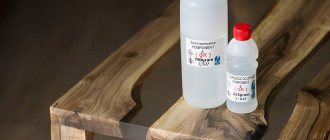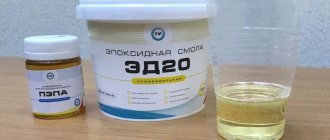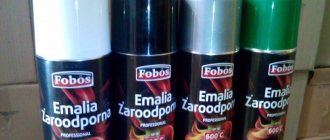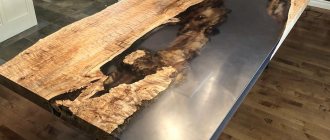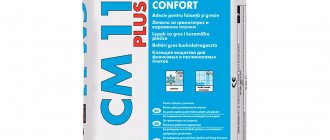Resin is a substance adapted to harden under certain environmental conditions. Resins exist both artificial (man-synthesized) and natural (wood). “Epoxy” (the common name for epoxy resin) refers to polymer resins, i.e. it contains oligomers - molecules that have a small, limited mass.
The main characteristics of resin as a substance include:
- Moisture resistance, ability to withstand open ultraviolet rays;
- The presence of extremely low susceptibility to destruction from alkalis and halogens, as well as acids;
- Ability to dissolve in acetone and esters;
- In the hardened state there are no emissions of (harmful) volatile substances.
Epoxy (transparent) resin contains two components, respectively, to obtain the final product you will need two chemical processes. The first mixing step produces a linear substance with a reduced molecular weight, which also has thermoplasticity. In the second stage (hardening), an insoluble and refractory solid is formed.
The most valuable feature of epoxy resin is its ability to quickly transition from a liquid to a solid state. At the same time, as a result of such a transition, some surfaces can be glued together with a sufficient degree of strength. Hence the demand for the mixture for both creative and household work.
Types and chemical compositions of resin used for casting
Epoxy has been used by people in everyday life for a long time. For any household work that requires a reliable and solid connection, it has become an indispensable assistant.
Based on their composition, several types of resin are distinguished:
- Epoxy-Dian, which are marked with the letters “ED” and have numbers 10,16,20 and 22. EP-SM-PRO resin also belongs to this series. These substances are widely used in both household and industrial areas: the production of complex materials (compounds) with the possibility of impregnation, the installation of self-leveling floors, the production of adhesive compositions, etc. This is not the entire list of applications of this type of resin;
- Epoxy diane used in the production of varnishes and paints. They are marked “E” with numbers 40 and 40-R. Indispensable in the creation of paint and varnish coatings;
- Epoxy-modified – marked “EPOPHOM” with numbers 1,2,3. Used for repair work;
- Special purpose epoxy. They may contain other substances, for example, resorcinol, chlorine, so their use is possible under special environmental conditions.
It is worth noting that any epoxy includes two elements - a hardener and the resin itself. And different fillers give it special properties.
Epoxy and its consumer qualities
The cost of this substance is quite high. Purchasing a small quantity for household needs will not particularly hurt your pocket, but purchasing large quantities will require considerable cash outlay. However, the popularity of resin among the population does not decrease. This fact can be explained by the excellent qualities of the polymer, which include the following:
- Bond strength. In some cases, with a high degree of compliance with the process technology, the hardened mixture may well provide worthy competition even to individual types of concrete;
- Heat resistance. The resin can successfully withstand high temperatures (+200 degrees Celsius and even higher);
- Moisture resistance. When hardened, the resin does not allow or absorb moisture at all;
- Adhesive properties. High level of adhesion, subsequent bonding strength, capable of gluing large surface areas;
- Practical resistance to most aggressive substances (for example, acids);
- Light weight when frozen.
The listed properties are typical for all types of these substances. Properties can be reduced or increased by adding special components to the resin used in its production. When purchasing epoxy resin, you must make sure of the intended purpose of the composition. This information can be obtained from the information written on the label or by consulting with a sales consultant. Even a slight deviation from the composition required for certain jobs can directly distort their results.
Areas of use of epoxy
The scope of its application is quite wide. The substance is very popular in use for both domestic and industrial needs. In turn, the technologies used for the manufacture of epoxy are being improved on an ongoing basis, which expands the scope of its application. At the same time, the composition acquires updated qualities.
Most often, resin is used in production to solve the following problems:
- Bonding surfaces and impregnating fiberglass. This is necessary for the construction industry, electrical engineering and radio electronics, aircraft and mechanical engineering, in the production of fiberglass, in the repair of cars and ships;
- Formation of a waterproofing layer. A similar symbiosis of epoxy with other materials is used to cover walls in rooms with high humidity, basements, swimming pools, and other containers in which liquids are stored;
- Creation of chemically resistant coatings for their interaction with internal/external environments, as well as protection of porous materials;
- Creating transparent parts and objects by pouring resin into molds. In the future, such parts can be subjected to cutting, grinding, and other mechanical processing.
If you need to glue hard surfaces, epoxy glue is much better suited than any other epoxy resin composition. Of course, the adhesion effect can be achieved, but a special composition (glue) will allow you to achieve much better results.
How to choose
When choosing an epoxy resin, you must first focus on the scope of application. There are absolutely professional compositions, they will be difficult to use at home. It is better to choose a resin that already includes a hardener. Usually its volume fully corresponds to the dilution standards for the resin package.
Related article: Interior wall painting
It is important to pay attention to the safety of the composition; it must be non-toxic. The hardening time of resins varies, it depends on the manufacturer and the maximum fill layer allowed. Capricious options, which are very difficult to finalize, are not at all suitable for amateur use. However, they make the highest quality products.
Initially, the resin is completely colorless; shades can be added to it with dyes. When choosing products, you need to pay attention to the possibility of combining the mixture with different dyes, decorative elements and pigments. To a large extent, all epoxy resins are compatible with standard colors.
Industrial uses of epoxy
The permanent emergence of new chemical compositions significantly expands the scope of use of epoxy. With its help, it has now become possible not only to glue large objects together, but also to make replacements for metal parts in different designs from it, which will significantly reduce both the cost and weight of the product.
The main areas of application include:
- Manufacturing of composite objects. Fiberglass and carbon fiber are made in a similar way by impregnating synthetic fabric with resin. Afterwards, these materials can be actively used in object-oriented modeling, when creating cars, airplanes, ships, and missiles.
- Furniture manufacture. These can be both ordinary options (for example, kitchen countertops), and real exclusive household decor (slab tables and countertops, artificial rivers and waterfalls, etc.)
- Production of waterproofing/electrical insulating materials. The resin acts as a dielectric and is also waterproof.
- Making jewelry and jewelry work. Resin jewelry looks great and is inexpensive.
- Repair and installation work. Using resin, you can treat a cracked tabletop, renew a floor, repair a small boat (a leak in a wooden fishing boat), patch up a car body, etc.
Working with resin is many times easier than working with ceramics/metal.
Criteria for choosing epoxy resin for crafts
Which epoxy resin is best to use for making jewelry is an important question for craftsmen. You need to know that in the creative workshop, a special decorative epoxy is used to make souvenirs and decorations. And for durable gluing of various objects, the structural mass is intended. Different quality requirements apply to different types of epoxy:
- Structural. It must be characterized by increased strength, hardness and have a fast hardening time.
- Decorative. The substance used in creativity must have good fluidity, transparency, and increased resistance to yellowing.
Transparency level
It is impossible to classify all types of epoxy as completely transparent substances. That is, the level of transparency declared by the manufacturer cannot remain so for a long time. Sometimes, under the influence of oxygen and sunlight, the surface of epoxy products becomes yellow and loses its aesthetic qualities.
Experts advise protecting souvenirs using epoxy from direct and prolonged exposure to sunlight.
Only high-quality substances can boast a good and long-lasting level of transparency. Other resins gradually become cloudy over time. By the way, when determining how to choose an epoxy resin, know that epoxy intended for gluing products has a low degree of transparency. And many modifications of structural epoxies can be brown or even black.
Drying time
Epoxy intended for creative work, in addition to its degree of transparency, has another distinctive feature. This is the polymerization time - after exposure to the hardener substance, the resinous substance hardens quite quickly. Complete hardening can occur after just a few hours. However, it is better to use the product only after 1–1.5 days.
The resin takes a long time to harden
Epoxy quality
Good designer products made from epoxy resin can only be made when using high-quality material. In order not to make a mistake in your choice, it is worth studying the rating of epoxy resins recommended for design and already tested by craftsmen. Only with high-quality material, the final products acquire a magical “floating in the air” effect.
Rules for preparing for pouring
The preparation of the resin composition must be carried out in strict accordance with the instructions, which are always attached to each factory container. The lack of instructions in the kit calls into question the quality of the resin itself.
The proportions that must be observed when mixing play a huge role. The usual ratio of resin to hardener is 10 to 1. In special-purpose formulations, the proportion can vary from 5 to 1 to 20 to 1. Methods for preparing small and large volumes also differ. A large volume should first be warmed up thoroughly in order to reduce the viscosity. It is worth remembering that every 10 degrees Celsius increase in temperature speeds up the polymerization process by a couple of times.
When heating the mixture, you need to constantly monitor its temperature. If you bring the substance to a boil, it will begin to become cloudy and foam. This composition will become unsuitable for work. Using special thinners, the viscosity of the mass can be reduced. However, it should be remembered that even minimal doses of these additives (5-7%) can significantly reduce the adhesive qualities.
Particularly relevant is the problem of purifying a substance from visible impurities before application. Therefore, it is prudent to prevent stains from appearing at all. If this trouble occurs, then it is better to carry out cleaning using a banal mechanical method. But it is not applicable to all surfaces. The use of special solvents may also not ensure the safety of surfaces. Both freezing and heating can also be used. But none of the listed methods gives a 100% guarantee of complete cleaning.
Characteristics of a popular variety - brand ED-20
Brand ED-20 is a two-component epoxy resin created on the basis of an oligomeric compound, for which a variety of bioorganic substances serve as hardeners. Depending on the hardener used and the proportion used, the physical properties of the resulting composition, as well as technical and operational characteristics, can vary significantly.
ED-20 is sold in different packaging, which is convenient for different needs
Epoxy grade ED-20 can be used for:
- creating composite materials in their pure form;
- production of epoxy adhesives and sealants;
- creation of reinforced plastic and protective coatings.
ED-20 is an explosion-proof material, but when exposed to open fire it supports combustion. In terms of the degree of danger to human health, ED-20 belongs to hazard class 2, because contains toluene and epichlorohydrin in small quantities.
Rating of the best epoxies for pouring for 2022
10th place: QTP-1130
An essentially universal brand designed for processing countertops. A good choice for beginners. The mixture itself is transparent and does not suffer from a yellowish tint. The reduced viscosity self-levels the surface and thoroughly fills voids. Scope of application: small tables.
Specifications:
| Name | Index |
| Coverage type | anti-slip, high-strength, self-leveling |
| Color | colorless |
| Consistency | liquid |
| Shelf life | half a year |
| Air humidity | 0.85 |
| Component ratio | 100:60 |
| Compound | Epoxy |
| PRICE, rub/kg. | 674 |
epoxy resin QTP-1130
Advantages
- Suitable for inexperienced craftsmen;
- Does not have side shades;
- Has a self-leveling effect.
Flaws
- Limited shelf life.
9th place: Art-Eco
The recommended maximum thickness of the applied layer should not exceed 5-7 mm. The quality of the components of the substance is very high, but strict adherence to proportions is required when mixed with the hardener. A slightly noticeable yellowish tint is possible, so its compositions are often tinted.
Specifications:
| Name | Index |
| Density, g/cm3 | 1.05 |
| Dynamic viscosity, Pa.s | 0.75 |
| Breaking stress, MPa | 65 |
| Tensile strength, MPa | At least 35 |
| Adhesion of impregnation from concrete, MPa | 2 |
| Relative elongation, in 5 | 5 |
| PRICE, rub/kg. | 1300 |
epoxy resin Art-Eco
Advantages
- Excellent penetrating ability;
- Stability of chemical properties;
- No pungent odor.
Flaws
- Full load on the treatment site is possible only after 7 days.
8th place: ED-20
Completely Russian development, made according to Russian GOSTs. It is characterized by high viscosity. Over time, transparency may decrease and a yellowish tint appears. However, this disadvantage is more than compensated for by the increased density and the substance is excellent for filling floors. A big plus is also the relatively low cost. Suitable for both experienced and novice craftsmen.
Specifications:
| Name | Index |
| Density, kg/m3 | 1.16 |
| Tensile strength, MPa | 40-90 |
| Polymerization temperature, degrees Celsius | 20 |
| Complete polymerization time, hour. | 24 |
| Moisture absorption, 24 hours in% | 0.001 |
| Impact strength, KJ/m | 5,25 |
| PRICE, rub/kg. | 505 |
ED-20
Advantages
- Good adhesion to glass, metal, ceramics;
- Resistance under the influence of aggressive environments;
- Full dielectric.
Flaws
- An outdated formula that is not always able to meet modern challenges.
7th place: CHS Epoxy 520
A high-quality mixture of Czech production, supplied complete with a specially developed hardener. Perfectly suitable even for such delicate work as compiling a herbarium. The main purpose is to work with small details and decor. Does not boil even when using large volumes
Specifications:
| Name | Index |
| Epoxy equivalent, g/mol | 182-192 |
| Hazen color, no more | 100 |
| Dynamic viscosity, at 25 g. Celsius (CPZ) | 12000-14500 |
| Proportion of hydrolyzable chlorine | 0.03 |
| Epoxy index | 5,2-5,5 |
| PRICE, rub/kg. | 1690 |
CHS Epoxy 520
Advantages
- High temperature of destruction of the hardened composition (from 90 degrees Celsius);
- There is no synthetic smell;
- Practically it is not subject to the formation of yellow spots.
Flaws
- Slightly increased elasticity.
6th place: Crystal Glass
This Russian product is characterized by high fluidity, and it is excellent for filling large surfaces. According to the instructions, after mixing with the hardener, which is sold in the kit, the mixture should sit for a short time. This will result in better viscosity. Professionals prefer to work with this epoxy.
Specifications:
| Name | Index |
| Color | Transparent |
| Life time at 25 gr. Celsius, min. | 35-40 |
| Shrinkage | 0.02 |
| Tensile strength, MPa | 60-80 |
| Compressive strength, MPa | 80-110 |
| Mixture density, g/cm3 | 1,0-1,1 |
| PRICE, rub/300 grams. | 570 |
epoxy resin Crystal Glass
Advantages
- Easy to prepare;
- Suitable for jewelry production;
- Has extreme transparency.
Flaws
- The high degree of thickening makes it impossible to make even minor adjustments to the treated surface (an awl does not take, you have to use small drills).
5th place: PEO-610KE
Special elastic resin, certified according to GOST. Elasticity is very suitable for processing countertops, because it allows you to evenly distribute the load on the load-bearing surface. Complete hardening – 2-3 days. In every sense it is a mid-level substance.
Specifications:
| Name | Index |
| Viscosity of the mass at +25 g. Celsius | 750 |
| Curing time, days | 02-03 |
| Hardness | 80 |
| Max. operating temperature (Celsius) | 80 |
| Price, rub/600 grams. | 1660 |
PEO-610KE
Advantages
- Suitable for making jewelry;
- Does not turn yellow;
- Withstands sanding very well.
Flaws
- Quite a high price due to the specific application.
4th place: EpoxAcast 690
Professional and expensive Russian-made compound. Used exclusively for jewelry. Suitable for countertops, but the required layer should not exceed 5 cm. Despite its strength and lightness, it may shrink slightly in large volumes
Specifications:
| Name | Index |
| Shrinkage, % | 0.25 |
| Tensile strength, MPa | 45 |
| Bending strength, MPa | 75 |
| Compressive strength, MPa | 66 |
| PRICE, rub/kg | 2010 |
EpoxAcast 690
Advantages
- Great for modeling and jewelry making;
- Supports the use of paints to create color images;
- Long service life of the composition (300 hours).
Flaws
- High price.
3rd place: MG-EPOX-STRONG
Epoxy from a German manufacturer. It has simply an impeccable reputation due to its versatility. It is characterized as an ultra-strong and ultra-transparent composition. The final hardening time is just under 3 days.
Specifications:
| Name | Index |
| Component ratio | 100:40 |
| Lifetime after mixing | 30 min. |
| Full hardening time | 72 hours |
| Transportation at sub-zero temperatures | Possible |
| PRICE, rub/kg. | 1100 |
MG-EPOX-STRONG
Advantages
- Unpretentious to the environment;
- Low probability of brown spots forming;
- Relatively low price.
Flaws
- Small filling thickness (up to 10 mm).
2nd place: Epoxy CR 100
A universal and extremely safe mixture that has all the necessary modern properties. It is characterized by increased wear resistance and antistatic properties. Product for professionals
Specifications:
| Name | Index |
| Density, g/cm3 | 1,07-1,08 |
| Viscosity, MPa | 800-900 |
| Mixture ratio | 1:10 |
| Compressive strength, MPa | 52 |
| PRICE, rub/10 kg. | 18300 |
Epoxy CR 100
Advantages
- Wide range of applications;
- Increased chemical resistance;
- Self-leveling ability.
Flaws
- Sensitive to use on contaminated surfaces (greasy stains, dust).
1st place: Magic Crystal-3D
Wear-resistant and durable epoxy, not afraid of exposure to open sunlight. Often used for making jewelry and flooring, with 3D imitation. Excellent for pouring smooth surfaces.
Specifications:
| Name | Index |
| Pour point, gr. Celsius | 25-50 |
| UV protection content | In stock |
| Component ratio | 100:50 |
| Complete liquefaction, gr. Celsius | 70 |
| PRICE, rub/set 160 gr. | 1050 |
epoxy resin Magic Crystal-3D
Advantages
- Ultra-transparent composition;
- Works great on glossy surfaces;
- Good fluidity, no bubbles.
Flaws
- Extended hardening of even small products (up to 48 hours).
FAQ
Where is epoxy resin used?
+
The range of applications is very wide. Varnishes, compounds, and glue are prepared from epoxy resins. They are in demand for waterproofing premises, manufacturing watercraft hulls, car parts, missile fasteners, as well as the production of souvenirs, decorative items, jewelry, furniture, etc.
Why do you need a hardener?
+
The main purpose of this component is to convert the epoxy resin into an infusible and insoluble state. After mixing with a hardener, it becomes ready for practical use.
Viscosity
One consumer needs a viscous composition for filling “lenses” with a high dome, while another, on the contrary, needs an extremely low viscosity for filling (impregnating) objects with a surface riddled with pores. Obviously, not a single brand of jewelry compound can solve all problems - they are too different among the craftsmen. In this regard, a series of five brands of PEO compounds makes it possible to select the optimal composition for a particular application in costume jewelry.
Due to the strong dependence on the temperature at which the compound is located, its viscosity is always measured under isothermal conditions. In Fig. Figure 3 compares the rheokinetic curves of a number of domestic and foreign jewelry epoxy compounds during their curing at temperatures T = 25 and 55 ° C. If we take as the “limiting” viscosity a value equal to 1500 mPa.s (when bubbles still come out of the compound naturally at room temperature), it is easy to see that the time available to the master when working with the Crystal resin compound (75 min) is two times less than with PEO-610KE-20/0 and EpoxAcast 690 (150 min) and almost three times less with PEO-510KE-20/0 (200 min). This means that when pouring the same volume into a mold, of all the listed brands it will be most difficult to get rid of bubbles in Crystal resin. And it is very difficult (almost impossible) - in the simplified compound KER-828/921(OP), because it gains a viscosity of 1500 mPa.s at room temperature literally after 2 minutes. That is why the scope of its use in jewelry is limited to the manufacture of thin coatings).
| Rice. 3 |
Increasing the temperature significantly reduces the viscosity of the compound at the beginning of curing. For example, the viscosity of the freshly prepared PEO-510KE-20/0 compound decreases several times: from 640 to 50 mPa.s with an increase in temperature from 25 to 55°C. In the temperature range close to room temperature, you can use an estimated rule of thumb: an increase or decrease in ambient temperature by 5 ° C, respectively, reduces or increases the viscosity of the compound by 1.5 times. It is important to remember that at the same time, as the temperature rises, another competing process starts - acceleration of the polymerization process. This leads to the fact that the viscosity, having reached a certain minimum, soon begins to increase rapidly. From Fig. 3 it can be seen that at T=55°C the time to reach the viscosity limit of 1500 mPa.s for the PEO-510KE-20/0 compound will be 75 minutes, as for Crystal resin at T=25°C. Thus, slight heating is a useful technological operation that promotes effective degassing of the compound and at the same time reduces its curing time.
CONCLUSIONS:
Based on the research results, recommendations were made for the selection of jewelry epoxy compounds based on the specific application in costume jewelry. For the first time, a comparison has been made of the optical, technological, operational and toxicological characteristics of domestic and imported materials. Rheokinetic curing curves at room temperature and T=55°C were studied. 11 important points are discussed in detail that determine the potential suitability of a jewelry epoxy compound for the manufacture of volumetric coatings, pouring into molds and simulating water, as well as its safety. It has been shown that domestic PEO compounds of the “20/0” series are not inferior to imported analogues in optical quality and resistance to UV irradiation, but at the same time cover a wider range of viscosity and viability.
Photofastness
In Fig. Figure 4 presents the results of a study of the photoresistance of the jewelry epoxy compound PEO-610KE-20/0 in comparison with foreign Crystal resin, MG-EPOX-GLASS and EpoxAcast 690. The samples were exposed outside (on the balcony) and inside (on the windowsill) of the room in the conditions of St. Petersburg . They did not cover themselves with anything, and before the experiments began they looked equally colorless. The photo was taken after the samples were insolated for 1.1 years inside (middle row) and outside (top and bottom rows) of the room. Naturally, the samples located outside received a large dose of UV radiation and, in addition, were exposed to wind, dust, snow and rain. From Fig. Figure 4 shows that the epoxy compounds PEO-610KE-20/0 and EpoxAcast 690 did not turn yellow at all after insolation in room conditions, but only slightly yellowed outdoors. In contrast to Crystal resin and MG-EPOX-GLASS, whose photoresistance turned out to be noticeably lower, see also table. 1. Under the same insolation conditions, yellowing of samples with greater thickness (bottom row) was more pronounced compared to that for samples with smaller thickness (top row).
| Rice. 4 |
Application area
The material has taken a strong position in industry and everyday life, but now more and more new areas of its mass application are emerging. The most common areas of use of the product are:
- impregnation of glass fiber, fiberglass;
- creation of fiberglass, carbon fiber, and other types of plastic;
- gluing of parts in electrical engineering, radio electronics;
- waterproofing of swimming pools;
- pouring floors and basements, developing casting compounds and plastic cements;
- production of paints, varnishes, impregnations, putties;
- inclusion of chemically resistant coatings;
- boat sealing;
- application in aircraft manufacturing, automotive industry, shipbuilding;
- creation of fasteners for ground-to-space rockets;
- sewing body armor;
- car body repair;
- production of jewelry, haberdashery, products for the kitchen, bathroom, home and everyday life;
- crafts;
- filling and sealing of boards and computer chips.
It is difficult to list all the areas and areas of use of epoxy. Where to get material for work? Various brands are sold in large markets (Castorama, IKEA), in all stores of construction and finishing materials.
LITERATURE
1. Samsonova E. Epoxy resin. Materials // https://polymerclayfimo.livejournal.com/1229420.html
2. Sous la pluie. Products - jewelry made of Crystal resin and epoxy resin // https://polymerclayfimo.livejournal.com/1653058.html
3. Semenikhina I. Working with PEO epoxy compounds in jewelry // https://www.lfpti.ru/lp_article_09.htm
4. Epoxy resin for jewelry // https://pokasijudoma.ru/lepka-iz-plastiki/epoksidnaya-smola-dlya-bijuterii.html
5. Golinsky I. Selection of resin, transportation, storage, mixing // https://shop.art-gi.ru/index.php/moi-raboty/about-smola-m/52-es01
6. Agafonova N. Jewelry resin. Lesson 1. What is jewelry resin. Varieties of resin // https://www.youtube.com/watch?v=KY6HGBKKhYQ
7. Titova Yu. MK epoxy resin and dried flowers - creating transparent jewelry without molds // https://www.livemaster.ru/topic/515633-mk-epoksidnaya-smola-i-suhotsvety-sozdanie-prozrachnyh-ukrashenij-bez- moldov
8. Yl-Ka. Master class on working with epoxy resin (compound) // https://stranamasterov.ru/node/427491
9. Non-standard lessons. Earrings “Paisley” epoxy resin and pearlescent dyes // https://vk.com/photo-43268093_326096857
10. Posta M. Epoxy bracelet in tablet forms // https://www.youtube.com/watch?v=nX—HGjiNKs
11. Video master classes on the use of jewelry epoxy resins. Digest //
12. Epoxy resins and polymer materials based on them. Catalog. Cherkasy. UkrNIIPlastmass. 1989.
13. Causes of errors when working with epoxy resins //
14.photonics110. About the photoresistance of PEO-510KE-20/0 and other epoxy compounds // https://crystalresin.livejournal.com/149041.html
15. Abstracts of articles and reports by employees of the Research Institute of Physics and Physics of St. Petersburg State Technical University (TU) on optical epoxy polymers //
16. Growth is delayed. // Fourth International Conference “Composites and Compounds 2015” https://www.creonenergy.ru/news/post_relizy/detailPost.php?ID=115223
17. What is your favorite compound? // https://poll.pollcode.com/qj9cz_result?v
18. Epoxy compounds for sealing optoelectronic devices //
19. Epoxy optical adhesives and compounds for a wide range of applications //
20. Restoration of museum exhibits using PEO optical adhesive compounds //
21. Heydur S.A. Jewelry epoxy compounds: properties and application features // Polymer materials. 2016. No. 4. pp. 26-31. https://www.lfpti.ru/SAGeidur_Jewelry-epoxy-compounds-properties-and-features-of-application.pdf
22. Optical epoxy compounds for jewelry (PEO jewelry resins) //
23. Optical adhesives. GOST 14887-80 //
24. Epoxy magic of costume jewelry. Samples of products based on PEO jewelry compounds //
25. Jewelry epoxy resins PEO from lfpti.ru // https://www.youtube.com/watch?v=88EjQx_bIqo
26. Li X., Neville K. Reference Guide to Epoxy Resins. M. Energy. 1973.
27. Dangerous chemical components in cosmetics. // FEMIANA https://femiana.ru/toksichnye-opasnye-dlya-zdorovya-veschestva-v-kosmetike
28. Instructions for the use of optical epoxy adhesive compounds for jewelry //
29. EXPERT OPINION No. 78.01.09.025.P.345 dated 02/14/2011 based on the results of a sanitary and epidemiological examination of products - epoxy optical adhesive compound of the PEO-10KE and PEO-510KE-20/0 brands. //
02.05.2016
The AUTHOR hereby grants you the right to copy this article solely for non-commercial purposes. The information cannot be used for other purposes, including in printed publications. By copying this article, you agree that you retain all copyrights and make a direct link to the source www.lfpti.ru/lp_article_18.htm. Except for the above, all other actions will be construed as indirect, intentional or any other misappropriation of copyright.
The relationship between components A and B
Since the densities of the components are different, accordingly the ratio A:B
will be different “by mass” and “by volume”.
Failure to take this circumstance into account is a common cause of errors when working with epoxy compounds. With the correct, so-called stoichiometric, ratio of components, all chemical epoxy groups will react with the hardener, and a homogeneous three-dimensional polymer network will be formed [26]
.
There is a common misconception that if you use more hardener than normal, curing will happen faster. In fact, if the ratio is incorrect, the excess of one of the components will remain in an uncured state between the mesh nodes, reducing the physical and mechanical characteristics of the epoxy polymer, its chemical resistance and resistance to heat. If there is a significant excess of hardener on the surface of the product, its gradual “sweating” is observed, and if there is a deficiency, “stickiness” is observed, already due to the unbound epoxy base (component A
).
The permissible error in weighed components is usually 5%. Therefore, to reduce the error, it is recommended to start the weighing procedure (measuring with a syringe) from component B
.
Let's look at this using the example of PEO compounds. As follows from table. 1 for these compounds the ratio A:B
= 100:25 = 4:1 by mass and
A:B
= 100:30 = 3.3:1 by volume must be met.
If you “missed” a little - you weighed (measured) a little more than component B
, for example, 1.1 g or 1.1 ml, then
weigh (measure) A 3.3 = 3.63 ml.
Let us note that the same sad consequences as with an incorrect ratio of components (including stains on the surface) can also result from poor mixing. For high-quality mixing of component B
pour into
A
slowly in a thin stream with constant stirring. Mixing should not be done intensively so that as few air bubbles as possible get into the mixture; The mixing duration should be at least 5–10 minutes until a homogeneous mass is obtained; there should be no optical inhomogeneities in it (all objects should be visible through the mass without distortion).

